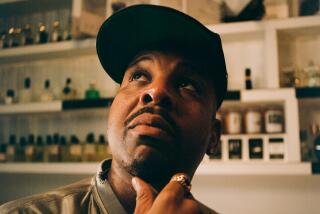For branding, many places adopt signature scents
Between the bouncy music and the stacks of colorful jeans, visitors to the Benetton store on Chicago’s Michigan Avenue might catch a whiff of a growing marketing trend.
Mounted high in the corner beside the store entrance, a scent diffuser, installed in November, spreads a bright spring fragrance modeled after Benetton’s Verde cologne.
“It finishes the emotion we are trying to create in the store,” said Robert Argueta, director of visual merchandising for the United Colors of Benetton, who also is testing the scent in Benetton’s New York flagship store. “It’s the first and last impression a customer gets.”
Long the domain of casinos and hotels, marketing using scent is catching on among retailers and in car showrooms, sports stadiums, airports, banks and apartment buildings that seek to distinguish themselves with customers via the deeply influential sense of smell.
“It’s a way to market above the clutter,” said Roel Ventura, a Seattle-based ambient designer with Ambius, which designs business environments.
The tactic also is gaining traction among businesses hoping to drum up sales, thanks to research that has shown the right scent can open people’s wallets, project a sense of comfort and home (think hotels), shorten the time people believe they’ve been waiting (think banking) or even improve one’s sense of performance (think gym.)
Although smells can be a turnoff or cause health problems for some people, the global scent marketing industry is growing, grossing an estimated $200 million in revenue last year and growing about 10% annually, said Jennifer Dublino, vice president of development at ScentWorld Events, the industry’s trade group in Scarsdale, N.Y.
Scent marketing is divided into two main categories: ambient scenting, which fills a space with a pleasant smell; and scent branding, which develops a signature scent specific to a brand, like an olfactory logo. The former can cost $100 to $1,000 a month depending on the size of the space. The latter can run anywhere from $3,000 to $25,000 plus a monthly maintenance fee.
If the aim is to improve consistency or to create or maintain an iconic brand, a signature scent may be best, said Ed Burke, director of marketing and communications at ScentAir, a leading scent marketing company based in Charlotte, N.C., that says it scents 70,000 locations, including Benetton. Less than 10% of the company’s clients go that route, he said.
“Hugo Boss is a great example of a signature scent,” said Burke, whose company created the rich tamboti wood scent that Hugo Boss pumps through its stores’ heating and air conditioning systems, the preferred delivery method for large spaces. The high-end brand, an early retail adopter of scenting in 2011, at the time sold its apparel mostly in other stores such as Nordstrom and Neiman Marcus, so scenting was a way to tell a consistent brand story, Burke said.
Some venues use multiple scents. The scent program at the Marlins Park baseball stadium in Miami, launched last month, includes the smell of caramel popcorn in the general concourse areas to create a “whimsical, family atmosphere,” a more sophisticated black orchid aroma in the stadium’s luxury Diamond Club, and a muted orange scent in the team store to reflect the stadium’s history of hosting the Orange Bowl, Burke said.
Some banks have signed on, with research suggesting that scent can shorten the time you feel you’ve been standing in line, said Roger Bensinger, executive vice president for AirQ, a division of Milwaukee-based Prolitech.
AirQ, whose retail clients include Abercrombie & Fitch, luxury designer Pierre Cardin, LensCrafters and Goodwill stores, also has several large gym chains in test mode, a promising opportunity because certain scents, such as peppermint and lemon, can improve the perception of performance, Bensinger said.
Perfumer Sue Phillips, founder of Scenterprises in New York, likes to call scent “the last branding frontier.”
Phillips, a veteran of the fragrance industry who has worked with Lancome, Tiffany and Burberry, said the scenting of spaces started in casinos 25 years ago to mask smoke odors. It has become far more sophisticated since.
Dawn and Samantha Goldworm, the twins behind olfactive branding firm 12.29, named after their birthday, took six months to develop a signature scent for the Thompson Hotels, including the one in Los Angeles, which “wanted to convey you sinking into a worn-in leather couch with a scotch,” said Dawn Goldworm. (She is the fragrance expert; her sister handles the marketing.)
The Goldworms asked Thompson executives to describe the colors and textures that represent the brand — aubergine, black, plush velvet, worn-in leather, mirrored surfaces — and set about capturing what those smell like. As it turns out, velvet smells like balsam and humid earth; mirrored surfaces like wet cucumber and geranium; leather, mercifully, like leather.
The feelings hotels and retailers wish to elicit through scent also are distinct.
“Most hotels want people to feel comfortable, like they’re coming home,” said Dawn Goldworm, who also has scented runway shows for designers including Rodarte and Zac Posen. “For retailers it is different. You want them stimulated, energized, excited.”
Jorge Trevino, executive vice president for brand operations at Thompson Hotels, said the significant expense of developing and maintaining the scent in lobbies and corridors (the rooms are unscented) is worthwhile to tie the brand together and give guests another way to remember their stay.
Scenting isn’t always an easy sell.
“People are skeptical, they worry we’re going to make them like Abercrombie,” Samantha Goldworm said. Abercrombie & Fitch is perhaps the best-known scented retailer, with its signature Fierce fragrance diffused so fiercely in its stores that a group of students called Teens Turning Green protested the practice a few years ago, claiming a potential health hazard.
Some environmental health scientists are concerned that scent marketing exposes people to chemicals that aren’t fully understood. Fragrance gets heat because the formulas aren’t required to be disclosed, so people don’t always know what chemicals are in them.
“With this particular trend, lack of disclosure and increased exposure to unnecessary chemicals are both at issue,” said Nneka Leiba, deputy director of research at the Environmental Working Group. Some synthetic musks, a common ingredient in fragrance, have been flagged as potential hormone disrupters, she said.
Scent marketers say that they abide by Occupational Safety and Health Administration standards and that the chemicals are in such low doses, they are far below any potentially harmful threshold. Complaints, they add, are very few.
At Thompson Hotels, a few guests have been so put off by the scent that they have threatened not to return, Trevino said. But the positive comments are “exponentially higher” than the negative, he said, and he credits the scent for driving repeat guests.
More to Read
Inside the business of entertainment
The Wide Shot brings you news, analysis and insights on everything from streaming wars to production — and what it all means for the future.
You may occasionally receive promotional content from the Los Angeles Times.








